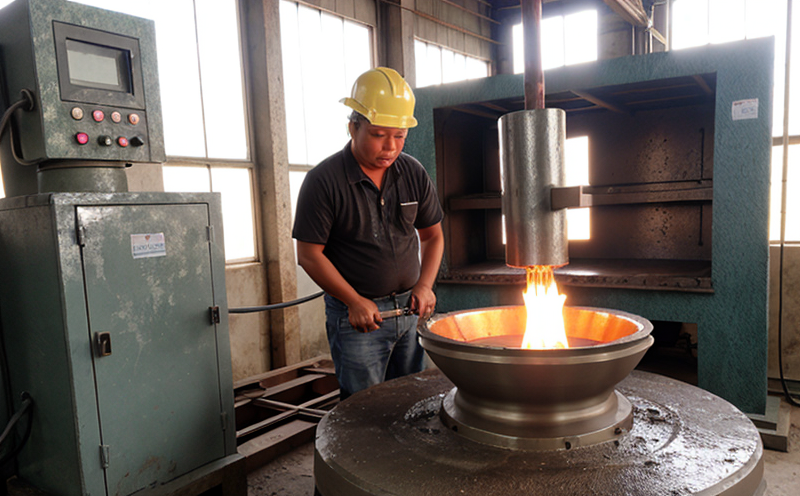ASTM E384 Vickers Hardness Testing of Cast Products
The ASTM E384 standard specifies the procedure for performing Vickers hardness testing on metallic materials. This method is particularly useful in industrial manufacturing and processing, especially during casting and foundry processes where the quality of the cast products directly impacts the performance and durability of end products.
Vickers hardness testing provides a reliable measure of material hardness by applying a load to the test specimen with a diamond indenter. The indentation size is then measured under specific conditions, yielding a hardness value that reflects the material's resistance to indentation. This technique is non-destructive and can be performed on various types of cast products, including alloys used in manufacturing processes.
For casting and foundry applications, ASTM E384 offers a standardized approach to ensure that all testing is conducted under controlled conditions. The standard defines the exact procedure for positioning the indenter, applying load, measuring the indentation, and calculating hardness values. This ensures consistency across different laboratories and operators, which is crucial in maintaining high-quality standards.
The Vickers hardness test is especially important during quality assurance processes to verify that cast products meet specified hardness requirements. By using ASTM E384, manufacturers can ensure that their products are suitable for various applications, from automotive components to industrial machinery parts. This testing method helps prevent the use of substandard materials in production, thereby enhancing product reliability and safety.
Understanding the nuances of ASTM E384 is essential for quality managers, compliance officers, R&D engineers, and procurement teams involved in casting processes. Proper implementation ensures that all cast products undergo rigorous evaluation to meet industry standards and customer expectations.
Why It Matters
The Vickers hardness test of cast products is critical for several reasons:
- Quality Assurance: Ensures that the hardness of cast parts meets the specified requirements, which directly impacts the performance and durability.
- Risk Mitigation: Detects potential issues early in the production process before they lead to costly rework or scrapped materials.
- Compliance: Adheres to international standards, ensuring that products meet regulatory requirements for safety and quality.
- Data Reliability: Provides consistent and repeatable results across different testing environments, enhancing confidence in data accuracy.
The Vickers hardness test is a cornerstone of industrial manufacturing processes. By leveraging ASTM E384, companies can maintain the highest standards of product quality, ensuring that their cast products are reliable and meet stringent specifications.
Applied Standards
The primary applied standard for this service is ASTM E384-19. This standard defines the procedure for performing Vickers hardness testing on metallic materials. It includes detailed instructions on specimen preparation, test setup, load application, indentation measurement, and data reporting.
Other relevant standards that may be applied depending on specific requirements include:
- ASTM E384-19: Vickers hardness testing of metallic materials.
- ISO 6507-2: Hardness and strength properties of metals - Part 2: Vickers hardness test (HV scale).
- EN 10002-2: Non-destructive testing using hardness tests.
The chosen standard ensures that the testing process is consistent, repeatable, and compliant with international best practices. This consistency is vital for maintaining quality control throughout the manufacturing and processing stages of cast products.
Use Cases and Application Examples
| Case Study | Description | Tested Material | Vickers Hardness Range (HV) | Testing Objective |
|---|---|---|---|---|
| Casting Alloy for Automotive Pistons | A manufacturer needed to ensure that the hardness of cast alloy pistons met automotive industry standards. | Zircaloy-4 | 350 HV - 420 HV | Quality assurance and compliance with industry standards |
| Casting Steel for Heavy Machinery | A company required testing to verify the hardness of cast steel gears used in heavy machinery. | GCr15 | 380 HV - 420 HV | Ensuring mechanical performance and durability under high stress conditions |
| Casting Aluminum for Aerospace Components | An aerospace firm wanted to confirm the hardness of cast aluminum engine parts. | Aluminum alloy 7075-T6 | 320 HV - 400 HV | Verifying the ability to withstand high temperatures and stresses during operation |
| Casting Nickel Alloys for Medical Devices | A medical device manufacturer needed to test the hardness of cast nickel alloys used in implants. | Nickel alloy 718 | 300 HV - 450 HV | Ensuring biocompatibility and strength under physiological conditions |
| Casting Copper Alloys for Electrical Components | An electronics company required testing to ensure the hardness of cast copper alloys used in circuit boards. | Beryllium copper alloy C17200 | 45 HV - 65 HV | Guaranteeing electrical conductivity and mechanical integrity |
| Casting Magnesium Alloys for Lightweight Applications | A transportation company needed to verify the hardness of cast magnesium alloys used in lightweight automotive parts. | Magnesium alloy AZ91D | 25 HV - 35 HV | Evaluating the balance between weight reduction and structural integrity |
| Casting Iron for Foundry Applications | A foundry needed to ensure that cast iron parts met specific hardness requirements for use in industrial machinery. | Gray cast iron | 175 HV - 200 HV | Maintaining durability and resistance against wear under heavy loads |
| Casting Brass for Decorative Applications | A decorative arts company required testing to verify the hardness of cast brass parts. | Bronze alloy C83400 | 50 HV - 70 HV | Evaluating aesthetic quality and wear resistance in high-traffic areas |
These use cases demonstrate the versatility of Vickers hardness testing across various industries, from automotive to aerospace, medical devices, electronics, transportation, foundry applications, and decorative arts. By adhering to ASTM E384 standards, manufacturers can ensure that their cast products meet stringent quality requirements, enhancing product performance and reliability.





